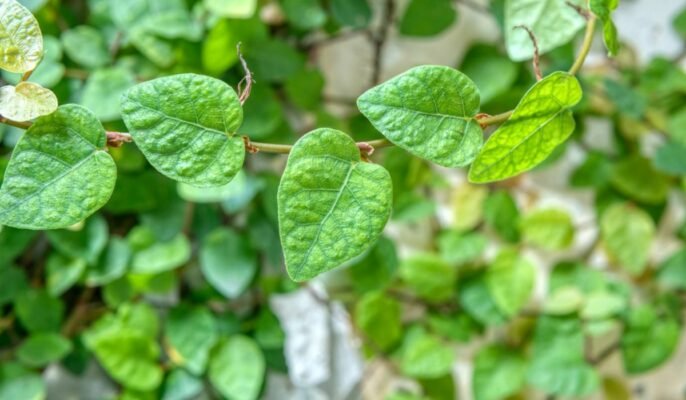The fig species Ficus pumila, sometimes referred to as the creeping fig or climbing fig, belongs to the family Moraceae. It is native to India, Indonesia, Malaysia and Papua New Guinea.
It is an evergreen tree growing to 15 feet tall outdoors with grey-green leaves and white flowers. The fruit is edible, containing a single seed surrounded by a large amount of fleshy pulp.
Ficus pumila: Quick facts
| Botanical Name | Ficus pumila |
|---|---|
| Common Name | Creeping fig |
| Genus | Ficus |
| Family | Moraceae |
| Life Cycle | Evergreen perennial plant |
| Species | F. pumila |
| Mature Size | Upto 15 feet |
| Cultivation | Tropical Asia |
| Benefits | Ficus pumila is used as herbal medicine or beverage |
Source: Pinterest
Ficus pumila description
Source: Pinterest
Ficus pumila is a large-leafed fig that can grow to be up to 12 feet tall. It is an extremely fast-growing plant that may reach heights of 20 feet within only a few years. This plant is also known as the creeping fig due to its resemblance to palms.
It has a very thin trunk and a thin, arching trunk with many branches covered in spines. The leaves are pinnate with up to 15 leaflets. The flowers are borne in clusters at the base of the branches, and they form fruit in late fall or early winter.
Although the creeping fig is not poisonous, it might lead to skin inflammation in some cases. It is also harmless to your pets.
How to grow Ficus pumila and growing tips?
Source: Pinterest
Ficus pumila is a very popular indoor plant. It can grow up to 12 feet tall outdoors. This tree has large, wide leaves with dark green on the top and lighter green underneath. The leaves are long and narrow, but they have a fine texture that makes them feel soft to the touch.
The Ficus pumila also has a short trunk with dense branches that are irregularly shaped and tapered at the ends. The leaves of this tree have sharp edges, which can cause them to shred easily when touched. This plant does not tolerate cold temperatures well either, so it should be kept away from drafts or other areas where it will freeze at night during winter.
The plant needs plenty of light to thrive indoors. So, it should be kept in an area with plenty of sunlight during the day. It is also imperative to consider airflow when growing Creeping Figs indoors. In order for the plant to grow properly, it needs to be kept in an environment with a constant temperature. Changing temperatures suddenly due to drafts will damage the leaves.
Ficus pumila should be fertilised once a month during spring and summer only, to ensure a faster growth rate. You can use time-release granules or soluble fertilisers for the most effective results when fertilising indoor plants. You should fertilise your ficus pumila every two weeks with a balanced liquid fertiliser.
Propagating Ficus pumila
- Indoor plants rarely produce seeds, so propagating them from seeds is not practical. However, creeping figs can be propagated by stem cuttings, which are easy to take and grow.
- Early spring is the right time to take a cutting from a fresh growth tip when plants begin to grow actively.
- It is not necessary to use rooting hormone when planting a cutting in sterile potting mix
- You should place the pots in a warm, humid area with good light, avoiding direct light. It may be helpful to enclose the pot in a clear plastic bag to keep the humidity in.
- Relocate to a more permanent container as soon as new growth appears.
Maintenance tips for Ficus pumila
While Ficus pumila plants are very slow-growing, they’re also incredibly resilient. They can survive in low light or areas with little humidity, making them great for indoor or outdoor use.
If you want to keep your Ficus pumila healthy and thriving, follow these tips:
- Give the plant some bright light. These plants can withstand moderate shade and do their best in regions with strong sunlight. If you live in a shady area, give your plant some extra light by placing it near a window or using fluorescent lights.
- Check the soil every so often to make sure it is not too dry or too wet. You should be able to comfortably squeeze water out of the bottom of the pot without having to change its position on the surface of your desk.
- Water every two weeks during summer months and weekly during winter months, as needed. The soil should remain moist but not soggy. Be careful not to overwater. This can cause root rot.
- Finally, remember that Ficus pumila does not need any fertilisers or pesticides in order to thrive. Except for making sure that you don’t over-water them. And allowing them time to dry out. It isn’t much else you need to do in order for them to flourish.
Ficus pumila uses
Source: Pinterest
- Ficus pumila has been used for medicinal purposes for centuries. The leaves of this tree contain a compound called saponin which helps to treat skin conditions, including acne and eczema.
- The roots of this plant are also used to treat diarrhoea, dysentery, and other digestive problems.
FAQs
Is sunlight necessary for Ficus pumila?
If grown outdoors, the creeping fig requires bright sunlight.
Does Ficus pumila grow quickly?
An evergreen self-clinging climber, the Ficus pumila plant grows very slowly.
How to care for Ficus pumila?
Reduce watering from fall to late winter after regular watering during the growing season. Pruning should be done as needed. Moist, well-drained soil is necessary for growing the plant outdoors in partial shade.
Does Ficus pumila climb walls?
Walls can be effectively covered with creeping fig Ficus pumila. As a self-clinger, it uses aerial roots, but it can leave its mark on paint when it pulls away.
Housing News Desk is the news desk of leading online real estate portal, Housing.com. Housing News Desk focuses on a variety of topics such as real estate laws, taxes, current news, property trends, home loans, rentals, décor, green homes, home improvement, etc. The main objective of the news desk, is to cover the real estate sector from the perspective of providing information that is useful to the end-user.
Facebook: https://www.facebook.com/housing.com/
Twitter: https://twitter.com/Housing
Email: editor@housing.com

